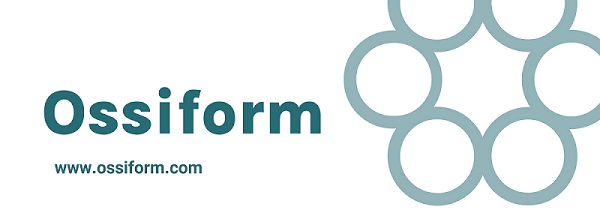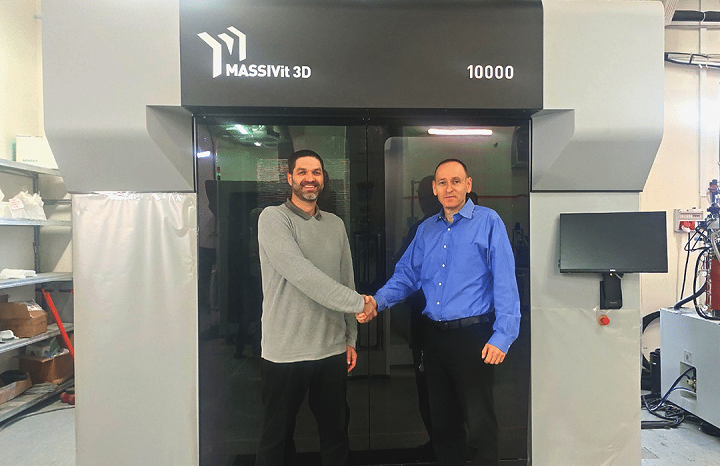First up in today’s 3D Printing News Briefs, Particle3D has gone through a rebrand, and a team of researchers developed a way to 3D print and preserve tissues in below-freezing conditions while keeping them viable for transplant. Massivit has expanded into the defense industry, and Alloyed 3D printed a copper cooling plate for use as a liquid cooling system in datacenters. Finally, a custom version of Aectual’s 3D printed Weave panels serves as a canopy for the Dutch House of Representatives.
Particle3D Rebrands to Ossiform
Danish medtech company Particle3D, which won our AMS Startup Competition in 2020, has completed a rebranding campaign, and is now called Ossiform. The “We Print Bone” tagline remains, but the company has grown and matured over the last couple of years, and as it approaches the launch of its first 3D printed bone implant for human use, this rebranding takes Ossiform one step closer to commercialization. The company’s previous name came from its patented powder particle-based 3D printing method, and its new name represents the efforts to supply 3D printed patient-specific bone implant products, with multiple benefits for healthcare providers and patients alike, that resemble real bone. Now that Ossiform has launched its new name, logo, and website, it can continue to focus on getting its products ready for the $4.8 billion bone implant market, and bring its P3D scaffolds into laboratories.
“It has been such an exciting journey the last two years with Particle3D, and I am proud to take part in the rebranding of the Company giving life to Ossiform and laying the path for the launch of the first P3D Bone,” said Ossiform’s CEO Thea Wulff Olesen. “Now the name is emphasizing what we do – We Print Bone – and according to plan we are ready to launch later this year.”
Researchers 3D Printing & Preserving Tissues in Cold Temperatures
Thousands of people die each year waiting for organ transplants, which is why research into bioprinted organs is so important. However, traditional and 3D printed organs are both viable for only a few hours, and must be kept cool during transport; too cold or too warm, and the cells can be damaged, meaning the organ is useless. But a team of researchers from Harvard Medical School, École de technologie supérieure (ÉTS), and McGill University believe they have a solution, and reported on their new technique, called cryobioprinting, in a recently published paper. The team developed a bioink—featuring various sugars and dimethylsulfoxide—that can safely freeze within milliseconds after it’s printed onto a -20°C cold plate, so the 3D tissue structure is preserved, with no worry that it could lose its intricate shape or viability. They demonstrated that with their technique, 3D printed tissues could be frozen safely for at least three months; once thawed, the cells in the tissues were still healthy and functional.
“It’s always been that you have to print a tissue and use it right away. This limits the ability for these constructs to be stored and/or transported among locations,” explained study coauthor Y. Shrike Zhang, a biomedical engineer at Harvard University. “Back in 2017 we started to think, ‘Can we devise some ways that could make it possible to bioprint and simultaneously store the tissues?'”
Massivit Moving into Defense Market with Strategic Collaboration
Large-format leader Massivit 3D has moved into the defense industries market for the first time, upon signing a strategic collaboration agreement with Kanfit, an Israeli manufacturer of metal and composite products for the aerospace, aviation, defense, and medical device industries. Kanfit manufactures parts and assemblies for some of Israel’s main aerospace players, including the Israel Air Force, Ministry of Defense, and others. Per the agreement, the award-winning Massivit 10000 3D printer will be installed at Kanfit’s plant for customer beta testing, and will be used to produce molds for manufacturing composite parts. The Massivit 10000 operates using the company’s cast-in-motion (CIM) technology, and preliminary sales for the system continue in the lead-up to its official launch; Kanfit’s order is the 14th one placed for the large-format printer.
“We are excited to sign the first agreement of this kind, for the strategic collaboration with Kanfit – one of the most important defense manufacturers in Israel,” said Massivit CEO Erez Zimerman. “This agreement is a momentous milestone in achieving Massivit’s goals and business strategy.”
Alloyed 3D Printed Copper Cooling Plate
The result of a merger between OxMet Technologies and Betatype in 2020, Alloyed offers next-generation performance for metal components through its alloy and process design technologies, and its 3D printed copper cooling plate, which was exhibited at Formnext 2021, was recently highlighted in the Cool Parts Show video series from Additive Manufacturing Media in Cincinnati, Ohio. The plate was designed for use in data centers, and because it’s a liquid cooling system, it can majorly reduce energy usage in comparison to more conventional air cooling methods. 3D printing is a good choice to make these cooling plates because it’s able to achieve more complex geometries with greater functionality and less parts, which equals easier installation and less maintenance. Copper can be tough to print because of its natural reflectivity and high thermal conductivity of the fused part, which is why Alloyed used partner JX Nippon Mining & Metals (JXNMM)’s copper powders, which are made with a novel surface treatment to keep electrical conductivity and porosity low on 3D printed parts.
“The success of the copper cooling plate that was on show at Formnext is due to the combined expertise of Alloyed and JXNMM,” stated Enrique Alabort, Co-Founder of Alloyed and Head of Alloyed Japan. “The materials developed by JX allow Alloyed to use its proprietary Engine® and Architect® software to produce the high-fidelity complex geometries and lattice structures in the cooling plate. Alloyed specialises in the production of fine-featured components and can produce thin walls down to a mean thickness of 190 microns, and its expertise in design for AM allows it to extract the most value from the design freedom enabled by the process. This expertise is vividly shown in the design and production of the copper liquid cooling plate.”
3D Printed Circular Canopy for Dutch House of Representatives
Zecc Architecten, which won ‘Dutch architect of the year 2020,’ designed a temporary venue for the lower house of parliament in the Netherlands, known as the House of Representatives or Tweede Kamer, while its normal complex is being renovated. The firm, which looks for elegant material solutions and technical components, decided to design a unique circular canopy for the building, and created a custom version of the 3D printed Weave Panels by Aectual, a Dutch design firm that offers 3D printed architectural and interior products such as flooring, room dividers, sound diffusion panels, and more. Bart Kellerhuis, the creative director of Zecc, had a chat with Hedwig Heinsman, the co-founder of Aectual, about what role circularity and recyclability played in the design of the canopy for the venue, which is meant to be a temporary government building.
“Circularity and smart use of materials was a part of the design brief, and the reason that the Aectual panels can be shredded and reprinted into new products was also one of the drivers to work with you. The building’s transformation was designed with a long term vision in mind, allowing for flexibility,” Kellerhuis said.
“…the columns are part of the fundamental identity of the building. They truly carry the building, connecting the roof and the floor and make it a whole. By making the columns curvy and soft we wanted to break with the rather boxy and square character of the building. And when we started to look for a circular material and innovative approach to create these soft surfaces we actually quite soon ended up at Aectual. There instantly was a mutual click since the team at Aectual speaks the language of the architect which made it easy – and fun- to work together. This really led to more quality; together we designed the surface solution based on custom fit Weave panels and the plan became better together.”
Subscribe to Our Email Newsletter
Stay up-to-date on all the latest news from the 3D printing industry and receive information and offers from third party vendors.
You May Also Like
Further Understanding of 3D Printing Design at ADDITIV Design World
ADDITIV is back once again! This time, the virtual platform for additive manufacturing will be holding the first-ever edition of ADDITIV Design World on May 23rd from 9:00 AM –...
3D Printer Maker EVO-tech Reborn as NEVO3D — Once More With Feeling
EVO-tech was a 3D printing service and original equipment manufacturer established in 2013 and based in Schörfling am Attersee, Austria. The company produced high-quality material extrusion systems featuring linear bearings,...
3D Systems Brings 3D Printed PEEK Cranial Implant to the U.S. with FDA Clearance
For more than 10 years, 3D Systems (NYSE:DDD) has worked hand-in-hand with surgeons to plan over 150,000 patient-specific cases, and develop more than two million instruments and implants from its...
CDFAM Returns to Berlin for Second Annual Symposium
The second CDFAM Computational Design Symposium is scheduled for May 7-8, 2024, in Berlin, and will convene leading experts in computational design across all scales. Building upon the first event...




































